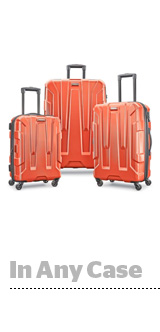 Working with Amazon is about going in with your eyes open, said Charlie Cole, global chief ecommerce officer at luggage juggernaut Samsonite and chief digital officer at Samsonite-owned Tumi.
Working with Amazon is about going in with your eyes open, said Charlie Cole, global chief ecommerce officer at luggage juggernaut Samsonite and chief digital officer at Samsonite-owned Tumi.
“Amazon has a proven track record of creating brands in a data-centric way,” Cole said. “I’m always a little surprised when people on the brand side represent Amazon as a principle sales channel.”
Cole, who oversees digital for Samsonite’s portfolio of brands, including American Tourister, High Sierra, eBags and Tumi, is realistic about his relationship with Amazon. The reach is unparalleled, but it’s not necessarily the most trustworthy fiduciary of a retailer’s first-party data.
“It all comes down to who owns the data, and on the internet, nine times out of 10, it’s not the brand – it’s Google, it’s Amazon, it’s Facebook,” said Cole, who came aboard at Samsonite after the latter’s $1.8 billion acquisition of Tumi in 2016. “That’s just the harsh reality right now.”
AdExchanger caught up with Cole to talk Amazon, CDPs and prepping for the holidays.
AdExchanger: What is your Amazon strategy?
CHARLIE COLE: The level of importance is almost a negative correlation with the price of the product. Put another way, Amazon is incredibly important, probably our first priority, for a mass brand like American Tourister designed to be at a $100 or $150 price point, but it’s less important for Tumi. For a premium brand like Tumi I want to do everything I can to make sure people have a direct relationship with the brand.
 It’s a remarkably informative exercise to go to any ecommerce platform, look around the room you’re in and just search for whatever you see: “Dog toys,” “headphones,” “aluminum luggage,” “golf clubs” – but not for a brand name like “Calloway.” What you’ll find is a bunch of people paying for ads at the top, and any products in the organic rankings are at entry-level price points. Keywords become really strategically important.
It’s a remarkably informative exercise to go to any ecommerce platform, look around the room you’re in and just search for whatever you see: “Dog toys,” “headphones,” “aluminum luggage,” “golf clubs” – but not for a brand name like “Calloway.” What you’ll find is a bunch of people paying for ads at the top, and any products in the organic rankings are at entry-level price points. Keywords become really strategically important.
Would it ever made sense for you not to sell on Amazon?
The logical, quantitative answer is, why on Earth would you not want to sell on the biggest product search engine in the world? But, qualitatively, there are a lot of reasons not to work with Amazon. One is that they don’t really focus on the brand. In some ways, they’re trying to democratize the concept of brand altogether.
There’s no other way to say it: Amazon is very Machiavellian to work with. They’re not your best friend and, frankly, they’re not on your side. In our case, you type in “luggage” and see a lot of AmazonBasics products. You could make the argument that we decided to sell with them and then they used our data to create products that cannibalize our business. A lot of brands are successfully avoiding working with Amazon altogether. Last year, the CFO of LVMH [which owns Louis Vuitton and Christian Dior] said there was no way they could do business with Amazon.
AdExchanger Daily
Get our editors’ roundup delivered to your inbox every weekday.
Daily Roundup
What should retailers consider before getting in bed with Amazon?
Don’t be blinded by short-term financial gains. You can’t say Amazon won’t attract shoppers – that’s what they do and they have more eyeballs on more products than anyone in the country – but before you enter into a relationship, take the long view. Play chess, not checkers. Make the decision that it’s better for the long-term health of your brand as opposed to making however many thousands of dollars during the holidays.
Speaking of the holidays, how early do you start planning and what does the process entail?
It’s never too early to start planning for the holidays. We started planning for 2019 in earnest [in September].
What other advice do you have for retailers around the holidays?
People underestimate the importance of financial planning. You can never disappoint your customers more than during the holiday season – it’s your biggest opportunity to screw up. The way to not screw up is by having a good understanding not just of your weekly or daily revenue, but your hourly revenue. You have to make an hour-by-hour forecast of your call center volume. If you didn’t staff your call center or your warehouse properly, you can underwhelm your customers at the time when their expectation and, arguably, their pressure is highest.
Then there’s the stuff people intuitively think of, such as digital marketing and technology readiness testing, but that takes the least planning, maybe two to three months out.
What’s the typical journey for your customers and what are you doing to optimize it?
It’s really hard to give a perfect answer to this question, primarily because Amazon doesn’t share all of the data and Alibaba doesn’t share all of the data, so connecting the dots is more of an educated guess than anything.
That said, one thing we see, specifically on tumi.com, is that well over half of purchases take at least three visits or touches and often many more to get to the finish line. That shows the challenge with ecommerce and how you need to create a balance between inspiration, education and transaction.
What makes it really hard, and this is something we could do a better job of, is quantifying business in Tumi owned-and-operated stores. A lot of consumers will browse online as an education tool, specifically with a plan of going into the store to buy.
But Tumi is doing some interesting work on the customer data platform front. How’s that going?
The initial uses of the CDP were really all front-end marketing challenges. The next challenge for Tumi is how to use the data for back-end customer service, warranties and repairs. It’s something, candidly, I’m more excited about than marketing. Is there a way we can use customer data to drive more loyalty so that it’s strategic for us?
That means we’d have a global customer data platform, and if something goes wrong with your luggage in Shanghai, for example, the rep there will have access to the same information as a rep in Jacksonville, Fla. or Brussels or Santiago, Chile.
We’re also having a conversation now about where our portfolio of data lives across Samsonite, Tumi, American Tourister, High Sierra, eBags and our other brands. Is there value in combining it all in one place and using it as a tool for more powerful marketing.
This interview has been edited for length and clarity.













